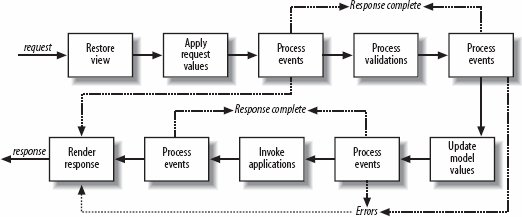Section 9.1. The JSF Lifecycle
9.1. The JSF LifecycleTo work within the JSF lifecycle, an application makes an XMLHTTPRequest to a URL that has a JavaServer Faces servlet listening. The JSF request-processing lifecycle consists of the following phases:
Figure 9-1 shows how a request moves through these phases. It's a simple high-level view of the JavaServer Faces lifecycle, but it illustrates the basic principle. The lifecycle begins with the Restore View phase and finishes with the Render Response phase, but a JSF request does not have to go through every phase of the lifecycle. Each Process Events phase gives the application a chance to handle any events (for example, validation failures) that occurred during the previous phase. Figure 9-1. The JavaServer Faces lifecycle |